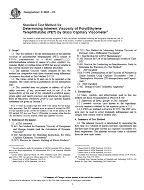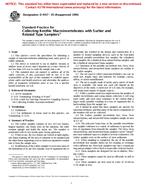1.1 This test method is designed to measure the anaerobic biodegradability of a material under conditions that simulate accelerated decomposition in a municipal solid waste (MSW) landfill. The test method requires the use of a 14C-labeled material so that biodegradability can be determined by monitoring for methane (14CH4) and gaseous and aqueous carbon dioxide (14CO2(g) and 14CO2(aq)), which are the terminal endproducts of methanogenic decomposition. Methanogenic conditions typically control decomposition in landfills.
Note 1 – A more complete description of this decomposition is found in Reference (3).
1.2 This method could be applied to landfills that contain materials other than MSW. 14C-Radiolabeled material will be added to compost such that between 25 ci and 75 µci activity per 2 litres of test refuse results.
Note 2 – Adding more radiolabel is desirable because, if the material biodegrades, there will be little residual radiolabel left at the end of the decomposition experiment, which is when the refuse is removed from a reactor and analyzed for residual radiolabel to perform a mass balance. In addition, if insufficient radiolabel is added, then CH4 and CO2(g) production from the added refuse will dilute the 14CH4 and 14CO2(g) from decomposition of the test material, and the labeled gases may not be detected in the reactor offgas.
1.3 This measure of anaerobic biodegradability in the laboratory represents what will ultimately occur in a landfill over a long period. The test conditions specified here are designed to accelerate refuse decomposition such that the entire decomposition cycle can be completed in six months.
Note 3 – This cycle may require decades in a landfill depending upon the actual environmental conditions (moisture content, pH, temperature).
1.4 The measured biodegradability obtained here is compared to the biodegradability of both pure and lignified cellulose, which are chemically similar to office paper and newsprint, both of which are routinely buried in landfills.
Note 4 – The degradability of the referenced compounds is described in References (2) and (5).
At this time, there is no standard concerning the extent to which a compound must biodegrade under the test conditions described here to be considered biodegradable. Thus, this test is most appropriately used to measure biodegradability relative to pure and lignified cellulose.
1.5 The safety problems associated with refuse and radioactivity are not addressed in this standard. It is the responsibility of the user of this standard to establish appropriate safety and health practices. It is also incumbent on the user to conform to all the regulatory requirements, specifically those that relate to the use of open radioactive sources.
Note 5 – There are no corresponding ISO standards.
Product Details
- Published:
- 03/10/2002
- Number of Pages:
- 9
- File Size:
- 1 file , 110 KB


